The Scream !!!
Referenced in everything from Home Alone to the horror movie Scream and the source of countless parodies, Edvard Munch’s painting The Scream (1893) is one of the most famous paintings of all time. Sometimes also referred to as The Cry, Munch's painting The Scream is known for its expressionistic colors, bright swirling sky, and—of course—its mysterious subject: a person clasping their face, screaming in anguish alone on a dock.
Why is the person screaming?
What is the meaning of the painting The Scream by Edvard Munch?

The Scream by Edvard Munch: Modern Art Analysis
So what is the meaning and story behind The Scream? In what he referred to as his “soul painting,” Edvard Munch reveals an honest and perhaps even ugly glimpse of his inner troubles and feelings of anxiety, putting more importance on personal meaning than on technical skill or “beauty,” a traditional goal of art. According to Munch’s diaries, the idea and inspiration for The Scream was very autobiographical, with the modern art painting’s content closely based on a personal experience first recorded in an 1892 diary entry which Munch later adapted into The Scream painting and finally, in 1895, a poem.
"I was walking down the road with two friends when the sun set; suddenly, the sky turned as red as blood. I stopped and leaned against the fence, feeling unspeakably tired. Tongues of fire and blood stretched over the bluish black fjord. My friends went on walking, while I lagged behind, shivering with fear. Then I heard the enormous infinite scream of nature."
Edvard Munch
So what is the meaning and story behind The Scream? In what he referred to as his “soul painting,” Edvard Munch reveals an honest and perhaps even ugly glimpse of his inner troubles and feelings of anxiety, putting more importance on personal meaning than on technical skill or “beauty,” a traditional goal of art. According to Munch’s diaries, the idea and inspiration for The Scream was very autobiographical, with the modern art painting’s content closely based on a personal experience first recorded in an 1892 diary entry which Munch later adapted into The Scream painting and finally, in 1895, a poem.
"I was walking down the road with two friends when the sun set; suddenly, the sky turned as red as blood. I stopped and leaned against the fence, feeling unspeakably tired. Tongues of fire and blood stretched over the bluish black fjord. My friends went on walking, while I lagged behind, shivering with fear. Then I heard the enormous infinite scream of nature."
Edvard Munch
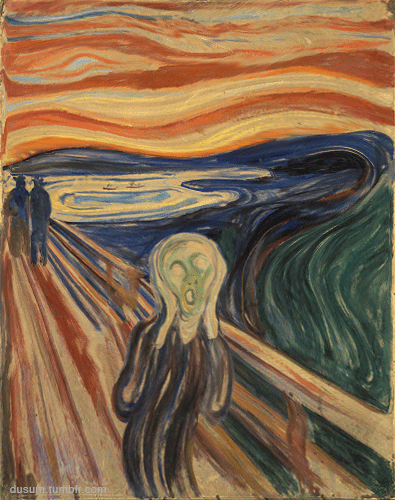
The Scream Meaning: Where is the scream coming from?
At the end of his poem, Munch mentions hearing “the enormous infinite scream of nature.” In fact, the original German title given by Munch to his work was Der Schrei der Natur ("The Scream of Nature"). Where does the “infinite scream of nature” come from? According to his poem, Munch was psychologically anguished during his experience by the fjord. In the painting, the subject’s mouth and whole face are pulled into the recognizable shape of a scream, but Munch tells us that he heard the scream - importantly, he does not say that he himself actually screamed (at least not out loud). Is this primal scream really coming from the person in the painting or somewhere else?
At the end of his poem, Munch mentions hearing “the enormous infinite scream of nature.” In fact, the original German title given by Munch to his work was Der Schrei der Natur ("The Scream of Nature"). Where does the “infinite scream of nature” come from? According to his poem, Munch was psychologically anguished during his experience by the fjord. In the painting, the subject’s mouth and whole face are pulled into the recognizable shape of a scream, but Munch tells us that he heard the scream - importantly, he does not say that he himself actually screamed (at least not out loud). Is this primal scream really coming from the person in the painting or somewhere else?
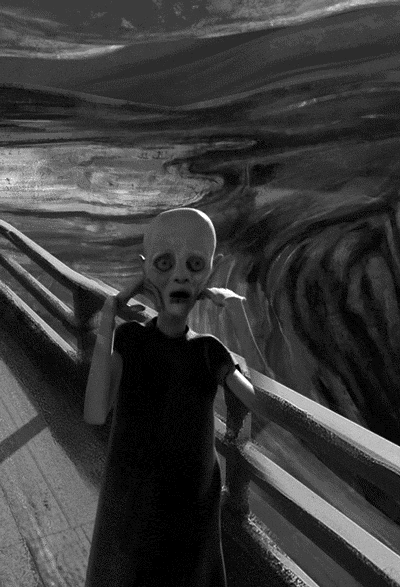

Art History Behind Edvard Munch's Expressionist Painting The Scream (1893)
The Norwegian artist Edvard Munch’s painting The Scream (1893) was painted at the end of the nineteenth century during a unique transitional period in art history, sometimes referred to as the fin de siècle.
While artists were once interested in painting their subjects objectively since their success was often measured by their technical skill, by the end of the nineteenth century brave artists like Edvard Munch were starting to use art to express inner thoughts, feelings and emotions instead, often by painting with bright, exaggerated colors and simple shapes. Though reviled by art critics and considered too radical in their time, artists like Munch and even Vincent Van Gogh paved the way for Expressionism and the even more progressive modern art movements of the twentieth century.
The Norwegian artist Edvard Munch’s painting The Scream (1893) was painted at the end of the nineteenth century during a unique transitional period in art history, sometimes referred to as the fin de siècle.
While artists were once interested in painting their subjects objectively since their success was often measured by their technical skill, by the end of the nineteenth century brave artists like Edvard Munch were starting to use art to express inner thoughts, feelings and emotions instead, often by painting with bright, exaggerated colors and simple shapes. Though reviled by art critics and considered too radical in their time, artists like Munch and even Vincent Van Gogh paved the way for Expressionism and the even more progressive modern art movements of the twentieth century.
Anxiety of the Artist
Like Vincent Van Gogh, throughout his life Edvard Munch struggled with anxiety and insanity-both on a personal level and indirectly, through his family. In fact, his mentally ill sister was hospitalized at the time The Scream was painted in 1893. Along with a slaughterhouse, the very mental asylum where Munch's own sister was hospitalized was located very nearby, too. Was the scream Munch heard actually coming from the insane asylum where his sister was? The true meaning behind The Scream may very well come back to the decidedly ugly, even hideous, sounds of living beings undergoing both physical and emotional suffering in the modern age.
Like Vincent Van Gogh, throughout his life Edvard Munch struggled with anxiety and insanity-both on a personal level and indirectly, through his family. In fact, his mentally ill sister was hospitalized at the time The Scream was painted in 1893. Along with a slaughterhouse, the very mental asylum where Munch's own sister was hospitalized was located very nearby, too. Was the scream Munch heard actually coming from the insane asylum where his sister was? The true meaning behind The Scream may very well come back to the decidedly ugly, even hideous, sounds of living beings undergoing both physical and emotional suffering in the modern age.
Screaming Man or Woman?
Who is the person in The Scream? In his poem, Munch describes almost an all-consuming black hole hell where "tongues of fire" savagely lick at the frazzled and overwhelmed person, unidentifiable as either man or woman. On first glance, Munch’s quote makes it seem that the painting is a self-portrait of the artist himself. While his experience by the fjord may have inspired The Scream, the hairless fetal person in The Scream painting is unrecognizable as either a male or female and has a gaunt, skull-like face. Due to the ambiguity of the subject's gender, the sexless person depicted in the painting may be Munch, or it actually may be Munch’s sick sister, hospitalized in the asylum nearby. In fact, it could be anyone...
Who is the person in The Scream? In his poem, Munch describes almost an all-consuming black hole hell where "tongues of fire" savagely lick at the frazzled and overwhelmed person, unidentifiable as either man or woman. On first glance, Munch’s quote makes it seem that the painting is a self-portrait of the artist himself. While his experience by the fjord may have inspired The Scream, the hairless fetal person in The Scream painting is unrecognizable as either a male or female and has a gaunt, skull-like face. Due to the ambiguity of the subject's gender, the sexless person depicted in the painting may be Munch, or it actually may be Munch’s sick sister, hospitalized in the asylum nearby. In fact, it could be anyone...
Edvard Munch - The Scream - 1893
The Scream Meaning (1893) by Edvard Munch
What is the meaning of Edvard Munch's 1893 modern art painting The Scream? When it all comes down to it, a "scream" is above all a sound and an auditory sensation. The screaming of both the dying animals and the cries overheard coming from the nearby insane asylum, however faint they may have been, give an added and potent personal meaning to the painting's simple title.
What is the meaning of Edvard Munch's 1893 modern art painting The Scream? When it all comes down to it, a "scream" is above all a sound and an auditory sensation. The screaming of both the dying animals and the cries overheard coming from the nearby insane asylum, however faint they may have been, give an added and potent personal meaning to the painting's simple title.
While the painting may have autobiographical and personal significance for Munch, one reason why The Scream painting is still so famous even today is because it is so universal in its meaning. Anyone can look at The Scream and feel something.
Meaning of The Scream (1893) Painting by Edvard Munch: Art Analysis
by K Shabi *12 June 2013
by K Shabi *12 June 2013


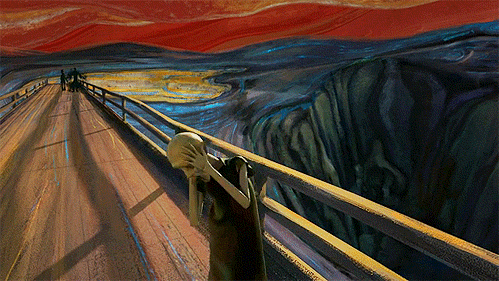
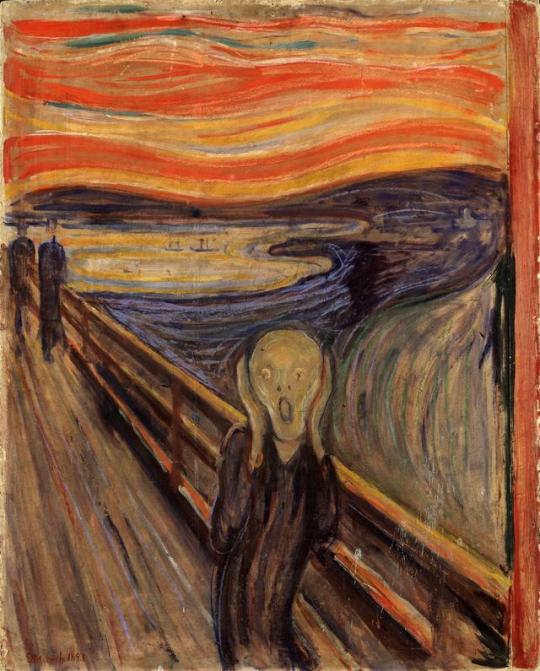
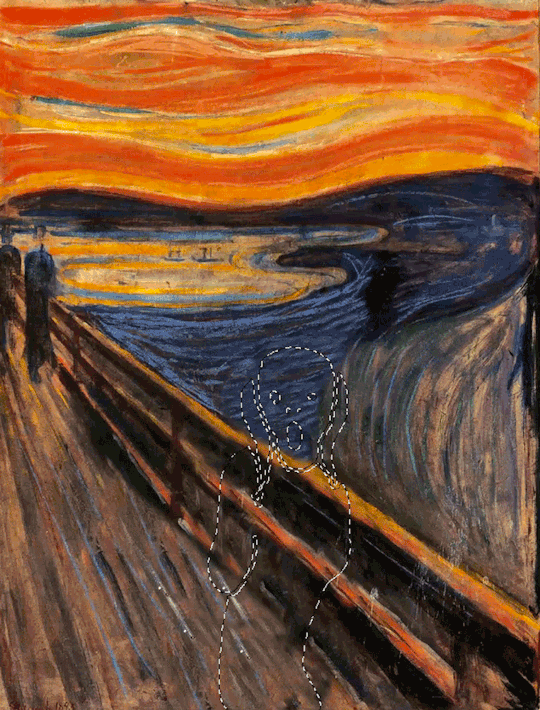
No comments:
Post a Comment